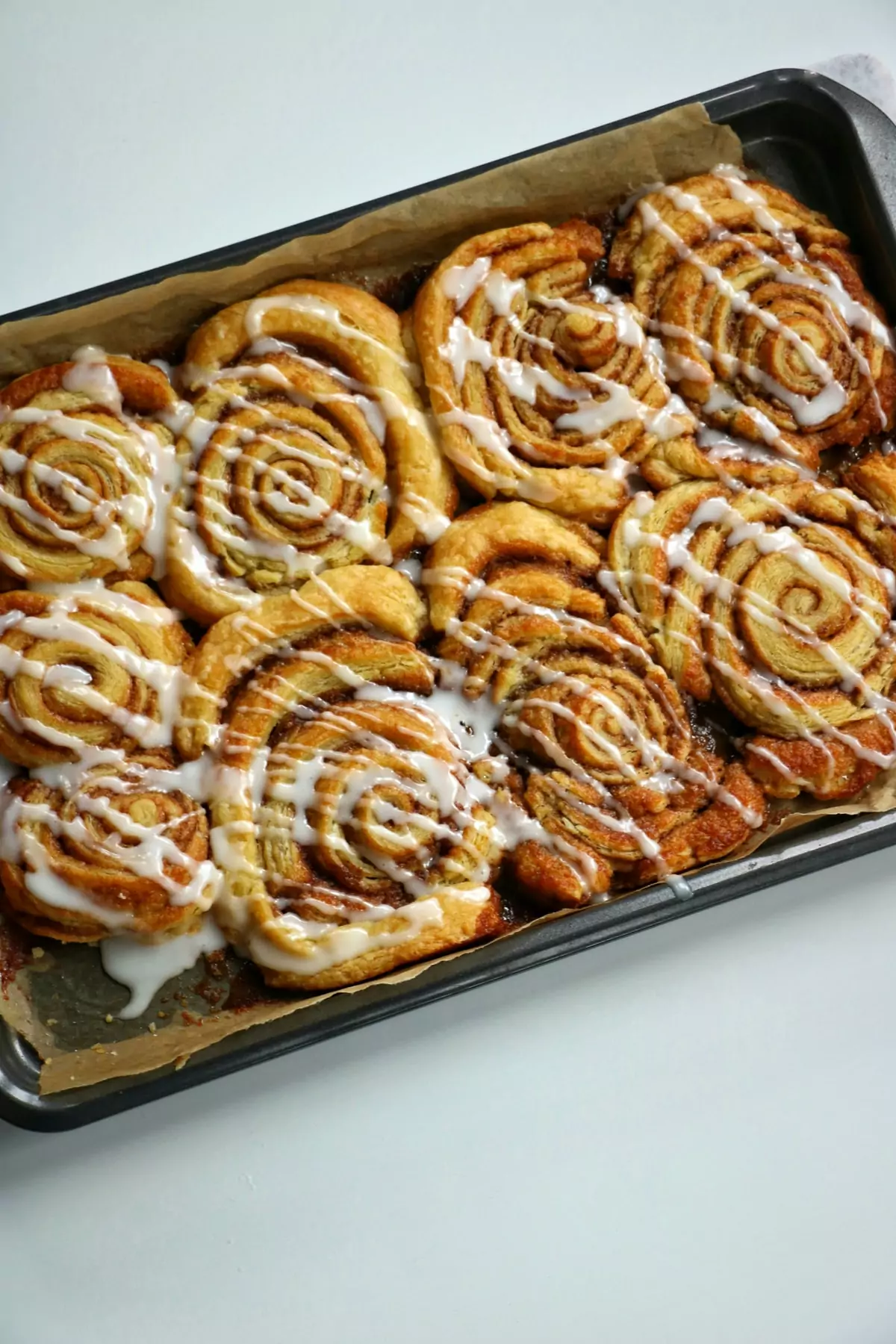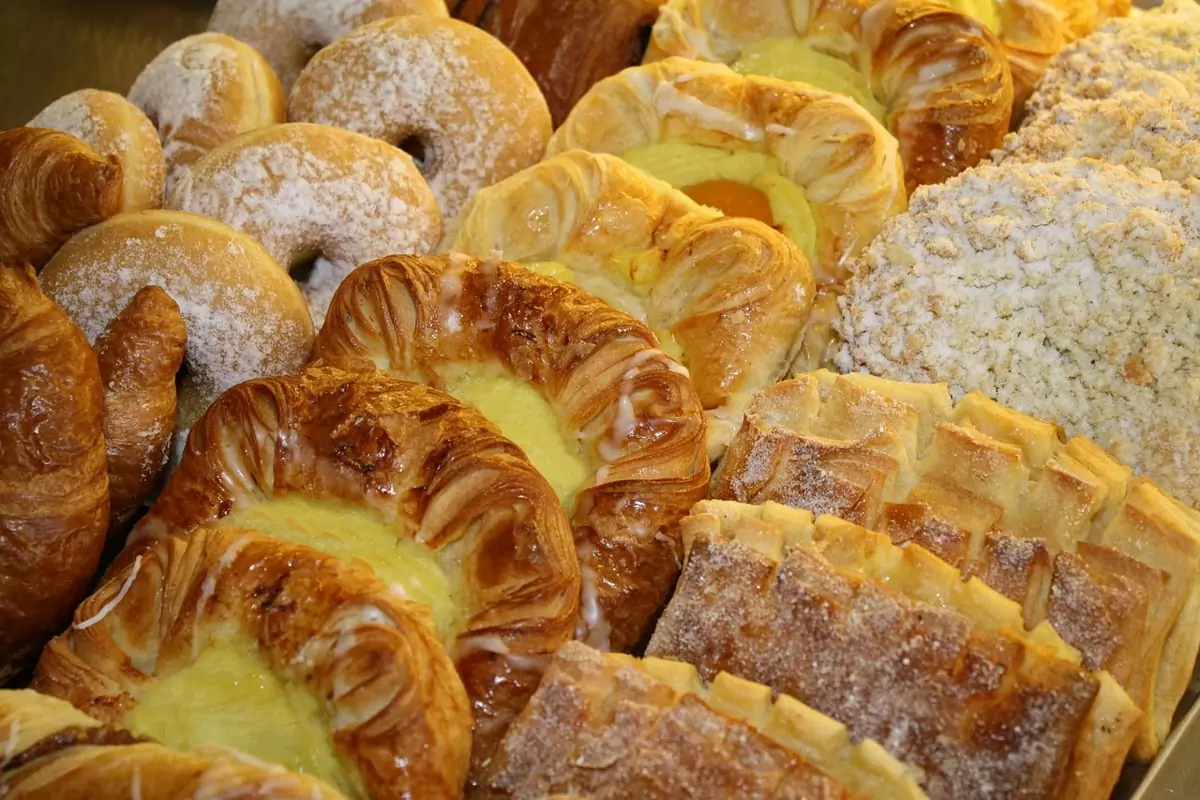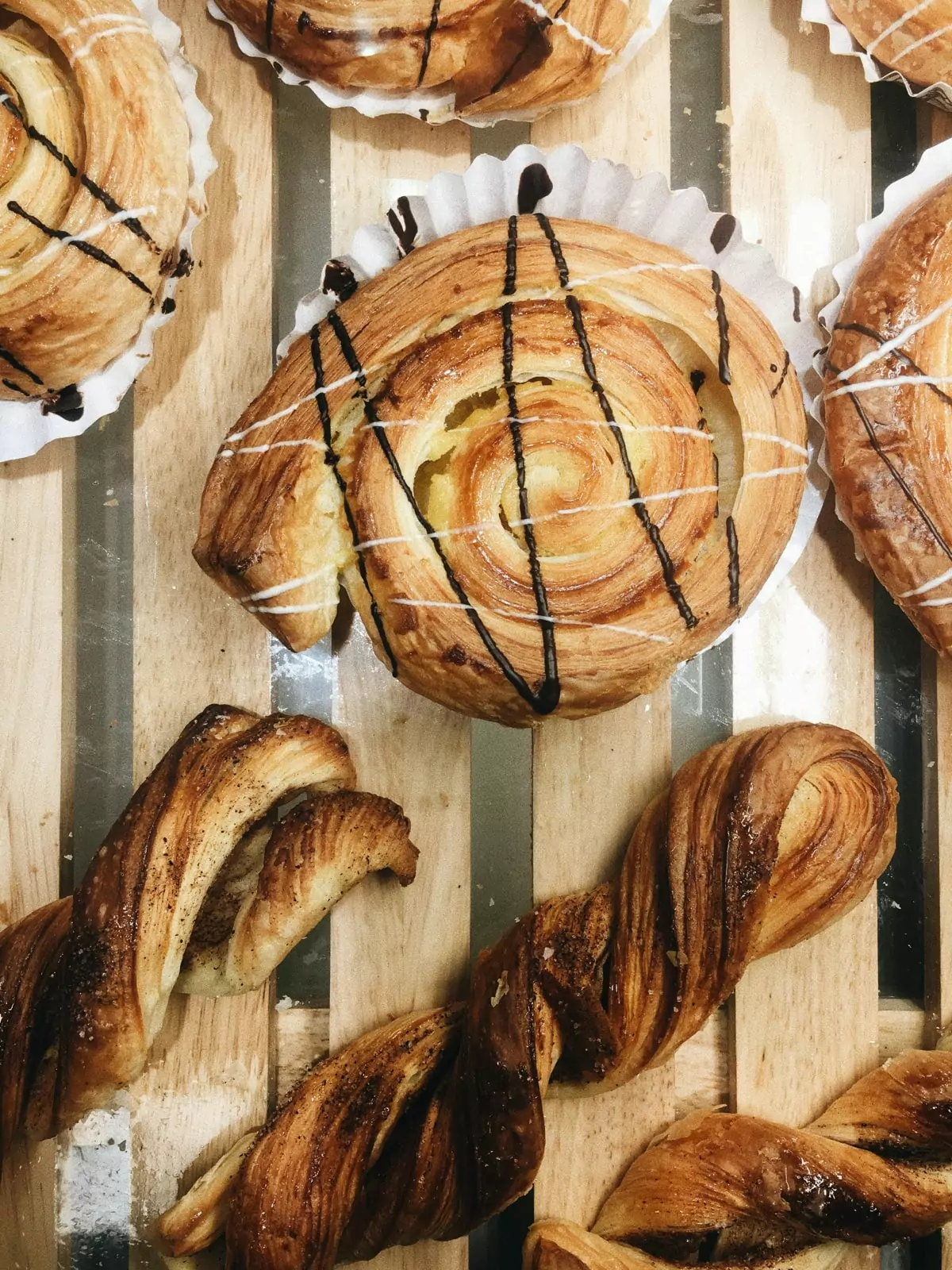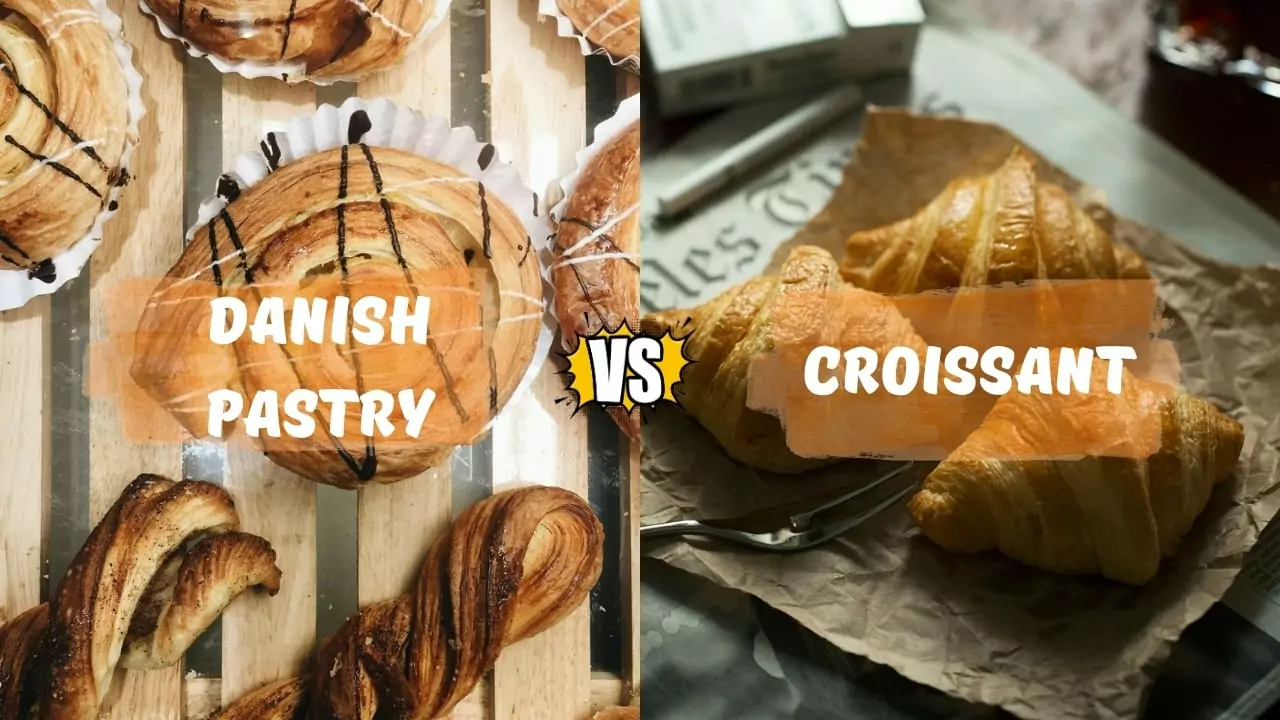The debate between Danish pastries and croissants is as rich and layered as the pastries themselves. Both evoke images of cozy cafes, the aroma of fresh baking, and the indulgent anticipation of a sweet treat. While they share similarities, such as their buttery and flaky textures, they are distinct in their histories, preparation methods, flavor profiles, and cultural significance. As we delve into the rich tapestry of these two delectable pastries, we’ll explore their origins, unique characteristics, and the nuanced differences that define each one.
Danish pastries, known in their home country as wienerbrød, bring to mind a world of delectable sweet or savory fillings nestled within delicate layers. Originating from traditions brought by Austrian bakers, these pastries have become synonymous with Danish culture and hospitality. On the other hand, croissants, which trace their ancestry to the Austrian Kipferl, have claimed their position as a quintessential part of French gastronomy. From their humble beginnings to their status as international favorites, both pastries have delighted countless palates around the globe, each radiating a unique charm that invites continued exploration.
In this exploration, we’ll draw comparisons and contrasts, discovering what makes each pastry a beloved choice for many. We’ll discuss their histories, preparation techniques, and the sensory experiences they offer, all while savoring the delightful dichotomy that distinguishes Danish pastries from croissants.
History and origins

Danish Pastry
The story of the Danish pastry is one steeped in the cultural exchanges of the 19th century. It traces its origins back to the contributions of Austrian baking techniques, carried over to Denmark by bakers who arrived while local bakers were on strike in the 1850s. Like a beautiful tapestry woven from diverse threads, Danish pastries were crafted by infusing local flavors with Austrian influences. Their unique name, wienerbrød, reflects their Austrian roots, taking inspiration from Vienna, the city synonymous with extraordinary pastries. These sweet delights not only made their way into Danish culture but quickly became emblematic of Danish hospitality and creativity, featuring a plethora of fillings and delightful shapes.

Croissant
On the other hand, the croissant’s lineage draws its richness from the Kipferl, an Austrian crescent-shaped pastry documented as early as the 13th century. Legend has it that during the 17th century Siege of Vienna, bakers, alerting their hidden city defenders of an enemy attack while crafting these crescent-shaped delights, cleverly celebrated their victory by symbolically creating a treat resembling the crescent moon reflected on the flags of their foes. Like a story passed down through generations, the Kipferl then journeyed to France, transformed with the luster of French culinary artistry, and blossomed into the flaky croissant we enjoy today.
Summary of History and Origins
| Feature | Danish Pastry | Croissant |
|---|---|---|
| Origin | Austrian bakers in Denmark (1850) | Austrian Kipferl |
| Cultural Association | Symbol of Danish hospitality | Quintessential French pastry |
| Main Ingredients | Butter, yeast, cream, filling | Butter, yeast, flour |
| Historical Influence | Strikes and labor challenges | Siege of Vienna |
These delightful pastries are not just culinary documents; they reflect the deep cultural values of their origins and the narratives that shaped their evolution. They invite us to appreciate not only the flavors but also the rich histories that ground them.
Origin of Danish pastries
Danish pastries, or wienerbrød, originated from the cultural assimilation of baking traditions brought to Denmark by Austrian bakers in the mid-19th century. When local Danish bakers went on strike around 1850, the Viennese bakers seized the opportunity, sharing their exquisite techniques and recipes with the locals. Through this cross-cultural exchange, the techniques of lamination and the creation of sweet pastries took root in Denmark, leading to the development of what we now recognize as Danish pastries.
The process of making Danish pastries involves incorporating layers of butter into a rich yeast dough, yielding a flaky and soft result. The dough often includes ingredients like cream, milk, and sugar that lend to a slightly sweeter profile. Unlike their French counterparts, Danish pastries are characterized by their variety of fillings, which can range from fruit jams to custards, cream cheese, or almond paste. This diversity reflects wienerbrød’s adaptability, making it a quintessential choice for family gatherings, celebrations, and festive events.
One of the unique elements of Danish pastries is not just how they are made, but also how they look. Bakers craft them into various charming shapes twists, spirals, and pinwheels, often topped with glaze, icing, or fruit to add visual appeal. Visually and texturally, they are an extraordinary experience, each bite revealing layers of flavor and sweetness.
Characteristics of Danish Pastries
| Feature | Details |
|---|---|
| Richness | Enriched dough with eggs, milk, and cream |
| Common Fillings | Fruit preserves, custards, cream cheese, almond paste |
| Shapes | Twists, spirals, windmills, envelopes |
| Toppings | Icing, streusel, powdered sugar, fresh fruit |
In summary, the origin of Danish pastries is a tale of cultural melding, creativity, and a commitment to deliciousness. With their exquisite layers and diverse fillings, they are not just a treat but a testament to the history that shaped them, celebrating the past while tantalizing taste buds today.
Origin of croissants
The croissant is a pastry with a rich history that spans centuries and countries, ultimately landing it a cherished place in French cuisine. Its earliest form can be traced back to the Austrian Kipferl, whose roots date back to at least the 13th century. Like an age-old heirloom, the story of Kipferl embodies resilience, first celebrated during the 17th century’s Siege of Vienna, where bakers devised crescent-shaped pastries in honor of the city’s triumph over the Ottoman Empire. This celebratory pastry represented both victory and creativity, capturing the hearts of those who enjoyed it.
The croissant as we know it today became popularized in France during the late 18th century, made famous by the Austrian princess Marie Antoinette, who brought the pastry with her to the French court upon marrying King Louis XVI. However, it was not until the 19th century that the croissant truly gained favor in France. February 1838 marked a pivotal moment when baker August Zang opened a Viennese bakery in Paris, introducing these flaky delights to a wider audience. As French bakers began to refine the technique of lamination, the croissant evolved into an iconic symbol of French baking artistry.
The word “croissant,” meaning “crescent” in French, began to appear around this time, reflecting its distinctive shape and rising popularity. As they transitioned from humble beginnings to a culinary staple, croissants became emblematic of French breakfast culture, often served alongside coffee or chocolate in bustling cafes.
Key Events in the Croissant’s History
| Date | Event |
|---|---|
| 13th Century | Origin of Kipferl, a crescent-shaped pastry |
| 1683 | Victory during the Siege of Vienna |
| Late 18th Century | Marie Antoinette introduces Kipferl to France |
| 1838 | August Zang opens Viennese bakery in Paris |
In conclusion, the origin of croissants weaves a narrative of victory, cultural exchange, and innovation. The evolution from Kipferl to croissant illustrates how a simple pastry can become an enduring symbol of a country’s culinary pride. Each bite of a croissant is a taste of history, celebrating the artistry of bakers who have perfected the craft over generations.
Influence of Austrian baking techniques
The intricate art of baking, particularly in the creation of laminated pastries, owes much to the Austrian techniques that have shaped beloved pastries like Danish pastries and croissants. This culinary influence illustrates how regional styles can interlace to create something truly magnificent.
Austrian baking emphasizes the technique of lamination, a process in which butter is repeatedly folded into a dough to create thin layers that puff up during baking. This concept can be likened to the beauty of origami each fold adds complexity and intricacy, with a delightful payoff in visual presentation and texture. The lamination technique creates the flaky and airy texture that both pastries are celebrated for today.
One of the key contributions of Austrian baking to Danish and croissant recipes is the use of yeasted dough. While both the Danish pastry and croissant maintain their unique characteristics, the basic concept of enriching a yeast dough with butter to achieve lift and flakiness remains a common thread. For Danish pastries, the dough often includes additional fat, like cream or milk, which lends a richness that enhances the pastry’s flavor, making them taste almost cake-like in certain varieties. In comparison, croissants are crafted with a leaner dough, focusing on the distinct flavor of butter.
Moreover, the folding techniques adopted from Austrian traditions differ slightly. Danish pastries commonly utilize a book fold, turning the dough over like opening a book, while croissants employ a letter fold, which is similar but offers distinct layering effects. These subtle differences in technique yield pastries with varied textures, reflecting the origin of each recipe.
Ultimately, the influence of Austrian baking techniques on Danish and French pastries speaks to the interconnectedness of culinary practices across borders. The mastery of lamination and the rich flavor profiles that result from these traditional methods highlight the trade of knowledge and creativity that transcends time, cultures, and geographical boundaries.
Preparation techniques
When it comes to preparation techniques, both Danish pastries and croissants require meticulous care and skill, akin to a painter crafting a masterpiece. While they may share the common foundation of laminated dough, their preparation methods differ, resulting in uniquely delightful pastries.
For Danish pastries:

Danish Pastry
- Creating the Dough: The basis of Danish pastry involves a rich yeasted dough, blended with elements such as butter, cream, and sugar, much like crafting a light yet indulgent cake batter. The enrichment leads to a flavor profile that is both sweet and tender, allowing for a luxurious eating experience.
- Laminating the Dough: The art of lamination begins with rolling the dough into a thin rectangle, then incorporating cold butter in layers. Through a book fold technique folding the sides of the dough and sealing them together layers are created that will puff up during baking.
- Chilling the Dough: Just as a painter takes breaks to assess their work, Danish dough requires resting intervals. The dough must be refrigerated between folding sequences to allow the gluten to relax and to keep the butter firm, ensuring fine layers remain intact.
- Shaping and Filling: After the dough has been rolled and folded multiple times, it is shaped into various forms, each offering a different visual appeal. Fillings can be applied before shaping, such as fruit, custards, or cheeses, heightening the overall flavor.
- Proofing: The final rise allows yeast to work its magic, creating an airy pastry with delightful layers. This step involves allowing the shaped pastries to rest until they double in size before baking.
- Baking: Danish pastries are typically baked at a moderate temperature, around 375°F (190°C), to ensure that they become golden brown and flaky without overcooking.
For Croissants:

Croissant
- Creating the Dough: Croissant dough starts similarly with flour, water, butter, and yeast. However, it remains less rich than Danish dough, focusing on the butter’s flavor to shine through in each flaky layer.
- Laminating the Dough: The traditional lamination process requires rolling the dough into a large rectangle and encasing a thick block of butter, folding it over like a letter. This repetitive rolling and folding creates the classic layers associated with croissants.
- Chilling the Dough: After each series of folds, the dough needs to be refrigerated to set the layers of butter. This chilling is fundamental to achieving the desired flakiness during baking.
- Shaping: Rolled out into triangles, croissant dough is crafted into the iconic crescent shape by rolling the triangle from the base upwards. This yielding process results in a lighter pastry that captivates with its flaky exterior.
- Proofing: Like Danish pastries, croissants are proofed before baking, allowing them to rise with lightness and airiness that characterize their structure.
- Baking: Croissants are baked at a hotter temperature of around 400°F (205°C) initially, producing rapid expansion of the dough, with a later decrease in temperature to ensure even baking and a beautifully golden appearance.
Summary of Preparation Techniques
| Preparation Aspect | Danish Pastry | Croissants |
|---|---|---|
| Base Dough | Yeasted, enriched with cream and sugar | Yeasted, leaner with less sugar |
| Laminating Method | Book folding | Letter folding |
| Chilling | Periodic resting between folds | Frequent chilling to maintain butter shape |
| Shaping | Various forms with fillings | Triangular, rolled into a crescent |
| Proofing | Final rise until doubled in size | Rising for an airy texture |
| Baking Temperature | Moderate (375°F/190°C) | Higher (400°F/205°C) followed by lower heat |
In summary, while both Danish pastries and croissants rely on similar techniques to achieve their distinct textures, subtle differences in dough formulation, lamination methods, and shaping contribute to defining each pastry’s identity.
Ingredients used in Danish pastries

Danish Pastry
At the heart of Danish pastries lies a delightful ensemble of ingredients that work together to create their characteristic flaky, rich texture and sweet, indulgent flavor. Similar to an artist relying on a vibrant palette, pastry chefs use a thoughtful selection of components when crafting these beloved treats.
- Flour: The foundation for Danish pastries is usually all-purpose or bread flour, which provides the necessary structure and elasticity to hold the numerous layers together.
- Butter: High-quality butter is essential. It plays a dual role by not only imparting a rich flavor but also serving as a lubricant during the lamination process. To achieve that desirable flakiness, cold, unsalted butter is typically used.
- Yeast: Active dry and fresh yeast are both commonly employed to provide the leavening necessary for pastries to rise, ensuring a light and airy final product.
- Sugar: Sugar sweetens the dough and assists in browning during baking, contributing to both flavor and appealing golden coloration.
- Eggs: Eggs enrich the dough, supporting flavor, color, and improved moisture retention. This enhances the overall texture, making the pastry softer and more luxurious.
- Milk and Cream: Dairy ingredients such as milk and cream lend moisture and tenderness to the dough, ensuring a soft crumb and enhancing the overall richness of the pastry.
- Fillings: While the dough is delightful on its own, the variety of fillings plays a vital role in the allure of Danish pastries. Popular fillings include fruit preserves (like raspberry or apricot), cream cheese, almond paste, custards, and even savory options.
Ingredients Breakdown of Danish Pastries
| Ingredient | Purpose |
|---|---|
| Flour | Provides structure and elasticity |
| Cold Butter | Imparts rich flavor and allows for lamination |
| Yeast | Leavens the dough, creating airy pastries |
| Sugar | Sweetens and enhances browning |
| Eggs | Adds richness and moisture |
| Milk/Cream | Contributes moisture and tenderness |
| Fillings | Varied flavors (sweet and savory) to enhance taste |
In summary, Danish pastries embrace a harmonious blend of ingredients, with each component playing a crucial role in achieving the desired texture and flavor. Their adaptability with fillings and shapes further melds culinary creativity with tradition.
Ingredients used in croissants

Croissant
The ingredients for croissants come together to create a delicate balance of flavor and texture, culminating in a pastry that is both indulgent and sophisticated. Like a craftsperson sourcing the finest materials, bakers choose each ingredient with precision to ensure the ideal outcome.
- Flour: High-protein bread flour is the foundation, lending strength and structure to the pastry while facilitating the formation of gluten that traps air during baking.
- Butter: The hallmark of croissants, butter is layered within the dough during lamination. Typically, European-style butter with higher fat content (around 82%) is used, enabling a significant contrast of rich flavor and flaky texture.
- Yeast: Active dry or fresh yeast is incorporated to raise the dough, which allows the layers to expand and achieve that distinct lightness.
- Water: Cold water is added for hydration, striking a balance that brings the dough together without making it too sticky.
- Salt: Essential for flavor enhancement, salt also works by strengthening the dough’s structure, ensuring robust layers upon baking.
- Sugar: It may be added in small amounts, primarily for flavor, contributing to a subtle sweetness that balances the rich buttery notes.
Ingredients Breakdown of Croissants
| Ingredient | Purpose |
|---|---|
| High-Protein Flour | Provides structure and elasticity |
| High-Fat Butter | Key flavor and texture, achieve flakiness |
| Yeast | Leavens dough for lightness |
| Cold Water | Hydrates the dough, binds the mixture |
| Salt | Enhances flavor and strengthens dough structure |
| Sugar | Adds subtle sweetness |
In summary, croissants flourish with simplicity, relying on high-quality ingredients that emphasize the flavor of butter while creating a lightness that is emblematic of French baking prowess.
Lamination methods for Danish pastries

Danish Pastry
The lamination process is crucial for producing the delightful layers that define both Danish pastries and croissants. However, there are notable differences in the techniques employed for each, leading to varied textures and characteristics.
- Initial Dough Preparation: The process begins with the creation of the base dough, which is rich due to the inclusion of butter, sugar, and eggs. This forms the backbone of Danish pastries. Each ingredient contributes to a moist, flavorful, and tender dough.
- Butter Layering: The cold butter must be rolled out into a flat sheet, ensuring that it can envelop the dough evenly. This butter block is placed in the center of the rolled-out dough, usually into a large rectangle, to ensure thorough coverage.
- Folding Technique: The technique used for creating layers in Danish pastries often involves the book fold, wherein the sides of the dough are folded towards the center and then halved. Each fold creates distinct layers of dough and butter.
- Resting Periods: After each turn, it is essential to chill the dough to keep the butter firm and allow the gluten to relax from rolling, typically resting for 20-30 minutes in the refrigerator. This step is crucial for maintaining the flaky quality of the final product.
- Shaping and Filling: After the requisite folds and resting periods, the dough is rolled out for the final shaping. The Danish can be filled with a variety of sweet or savory fillings, enhancing the final product’s flavor.
- Final Baking: The baking process involves a moderate temperature, allowing the dough to rise and puff against the butter layers, which results in beautifully flaky pastries.
Lamination methods for croissants

Croissant
The croissant’s lamination process is similar in concept but differs in execution, highlighting the artistry involved in creating these delightful pastries.
- Creating the Dough: The dough mix for croissants follows a more straightforward recipe, but achieves a rich flavor through the integration of high-fat butter.
- Preparation of the Butter Block: The butter block, or beurrage, should be pounded into a flat, uniform rectangle. This careful preparation ensures it can be evenly incorporated and layered into the dough.
- Enclosing the Butter: The rolled-out dough (detrempe) is wrapped around the butter, completely encasing it. This creates a layered mass that will be folded multiple times.
- Folding Technique: Croissants typically use a letter fold, which consists of rolling out the dough into a rectangle and then folding it into thirds, similar to folding a letter. This method creates distinct, flaky layers essential for croissants.
- Chilling Intervals: After each fold, the dough must rest in the refrigerator for periods ranging from 30 minutes to an hour, promoting relaxation and preventing butter from melting.
- Shaping: Once the dough has been folded an adequate number of times, it is rolled out, cut into triangles, and then shaped into the crescent form.
- Final Baking: Croissants typically bake at a higher initial temperature, which allows for rapid expansion and puffing, giving them a light, airy quality.
Summary of Lamination Methods
| Aspect | Danish Pastries | Croissants |
|---|---|---|
| Initial Dough Preparation | Rich dough with eggs and cream | Leaner dough with high-fat butter |
| Butter Layering | Rolled flat, placed in the center | Pounded into a rectangular block |
| Folding Technique | Book fold | Letter fold |
| Resting Periods | Shorter resting intervals | Longer chilling times between folds |
| Final Shape | Various shapes and forms | Classic crescent form |
| Baking Temperature | Moderate (375°F/190°C) | Higher initial heat (400°F/205°C) |
In conclusion, the lamination processes define the unique textures and characteristics of Danish pastries and croissants. While they share the common foundation of layering dough and butter, each method lends itself to a different pastry style, demonstrating the intricate craft of baking.
Textural differences
When devouring a Danish pastry and a croissant, one of the clearest distinctions lies in their textural qualities. Each brings a unique eating experience, offering contrasts that reflect their diverse histories and preparation methods.
Flakiness of Danish pastries
Danish pastries are characterized by a flaky exterior that crumbles gently with each bite. The layers crafted during the lamination process grant them that soft and tender quality, with noticeable separation between the layers. Imagine the pastry as a soft blanket of delicate textures enfolding sweet layers and fillings every bite is a contrast of crispness outside and moistness within.
The richness of the dough, enhanced by the incorporation of cream, milk, and sugar, adds to the indulgence. The fillings ranging from sweet fruit preserves to creamy cheeses add an extra layer of moistness that mingles beautifully with the flaky layers. The result is a pastry that, while undeniably flaky, tends to be slightly denser and more robust compared to its lighter counterpart, the croissant.
Crispy texture of croissants
Conversely, croissants present a strikingly different textural experience. Their exterior is crisply golden-brown, thanks to the higher baking temperatures and the intricate lamination during preparation. The layers puff up beautifully, producing a pastry that crunches delightfully when bitten into, akin to the crack of a perfectly baked cookie.
The lightness and airiness of a croissant come from its layered construction, leading to an exceptionally flaky, tender interior. Each bite reveals a delicate balance crisp outer layers juxtaposed with a soft, buttery core. This contrast enhances the enjoyment, making croissants feel like they are melting in your mouth as the buttery notes dance across your palate.
Comparison of Lightness and Airiness
When comparing lightness and airiness, croissants clearly take the crown. The croissant’s signature characteristics lie in its remarkably airy texture, achieved through meticulous folding and baking techniques. Each croissant is built with a series of thin layers that allow for ventilation during baking, creating the buoyant pockets that contribute to its hallmark fluffiness.
Danish pastries, while still possessing an enjoyable lightness, are denser due to their richer dough composition and the use of fillings. The variations in preparation techniques give Danish pastries a satisfying quality, yet they do not achieve the same airy structure that croissants embody. The Danish’s tender layers create a softer mouthfeel, where each bite is more about a rich indulgence rather than the pursuit of that delicate flakiness.

